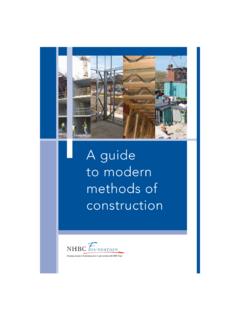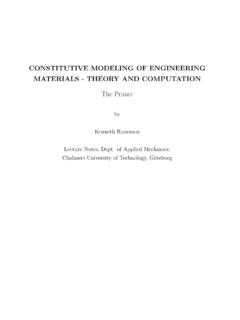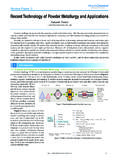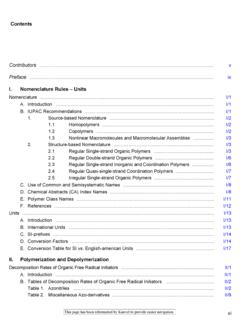Transcription of Historical introduction to the development of …
1 Historical introduction to the development of Material Science and Engineering as a Teaching Discipline by Clive Ferguson Page 2 1 introduction Metals have long held the dominant position as the most important engineering materials; steel being by far the most significant over the past few centuries. Nevertheless, increasingly in many areas this position is being challenged by other materials such as plastics, ceramics and composites. The relatively recent development of materials science and engineering (MSE) is a merger of metallurgy with polymer science, physical and inorganic chemistry, mineralogy, glass and ceramic technology and solid state physics (Cahn, 2001) to include all structural and functional materials, thus making it one of the broadest of study disciplines.
2 The material science concept developed from metallurgy in the 1950 s almost simultaneously in the GE research laboratories in the USA, the University of California Los Angeles (ULCA), and Northwestern University (Cahn, 2002). The COSMAT report of 1974, written to ostensibly persuade the scientific committee of the existence of MSE (Cahn, 1992), defined MSE as being concerned with the generation and application of knowledge relating the composition, structure and processing of materials to their properties and uses (ibid.). Cahn observes that since 1974 the main focus of MSE has moved from structure, and especially structural defects, to the influence of processing variables.
3 From the dawn of human existence materials have been fundamental to the development of civilisation. Anthropologists define the Historical epochs by the materials used by the different civilisations such as the Stone, Copper, Bronze and Iron ages. The different rates of progression towards more sophisticated materials between cultural groups correlated with different levels of innovation and the local availability of those materials, and led to varying standards of living. The early lack of technological information diffusion led to significant differences in advancement between cultures at any one time.
4 For example, in 1500BC those in Asia Minor (Turkey) were already experimenting with iron, whilst in Mesopotamia (Iraq) they were still in the Bronze Age. The Europeans, Palestinians and Egyptians were in the Copper and early Bronze Age; the Chinese had melted iron and were advanced in the development of Bronze; the Spaniards and Portuguese were still in the Chalcolithic period (an overlap of the Stone and Copper Age) whilst in North Africa there was still evidence of the late Stone Age. Those in the Americas were also still in the Chalcolithic period having not yet discovered bronze, but they made beautiful artefacts of gold, silver and copper - metals they found naturally ( not combined with sulphide, oxide or other ores).
5 The Native Americans (unfortunately) had not progressed from the Chalcolithic period three millennia later when the Europeans arrived with steel guns to conquer, colonise and settle (Ohring, 1995). Even more recently, in the late 19th century the first white settlers found Australia rich in minerals of all kinds, however there too there was no evidence that the aborigines had made practical use of these minerals in their metallic form (Raymond, 1984). Metallurgy, defined as the science and art of processing and adapting metals (Polmear, 1972), has been around for approximately 6000 years from when Neolithic man recovered and used metals through observation and deduction (Charles, 2002).
6 Page 3 Some significant developments took place in the pre-Roman period, cold welding; the lost wax process for bronze castings including high lead additions to improve fluidity; and the control of carbon content in iron, forging and the heat treatment of steel. Manufacturing techniques improved steadily during the Greek and Roman periods but without any major progress in alloy development . In the Post Roman period metallurgy moved into the secretive period of alchemical experimentation, with an emphasis on precious metals, amalgams and chemical properties (ibid.)
7 Some advances were made and the emergence of chemistry as an independent discipline can be traced to the need for assaying for standards of trade (Charles, 2002). However alchemy in the form of a belief in transmutation persisted into the 17th century. Even Newton (Warden of the Royal Mint) held some faith in it (ibid.)! In the 18th and 19th centuries developments in iron and steel issued in the machine age that led the Industrial Revolution that was to transform Britain from a mainly agrarian economy to an industrial economy.
8 This period was also called the Metallurgic Age (Skrabec, 2006). However during the 20th century there ensued an explosive increase in the understanding of the fundamental nature of materials which has led to phenomenal advances across a wide range of materials, dwarfing those of previous ages. In this chapter we first study the significant Historical contribution of metallurgical developments to the burgeoning UK industrial economy throughout the (first) Industrial Revolution, as well as the subsequent impact of poor 18th century science and engineering education.
9 The latter part of the Industrial Revolution also marked the start of UK scientific development , the naissance of metallurgy as a profession, and subsequently the origins of metallurgical education. We then consider the Historical development of each major precursor MSE science before looking at the emergence and development of MSE as a teaching discipline. 2. The significance of metallurgy to the Industrial Revolution In 1700, although most employment was still in agriculture, England was already an important industrial country.
10 The most famous of English industries at that time was the manufacture of woollen cloth which was the chief export, with leather goods and ironware coming second and third. Sheffield had long been famous for its cutlery. Firearms, nails, hardware and metal trinkets were manufactured in districts around Birmingham. Most of industry at that time was domestic, work carried out in the worker s own homes. Although many new iron built machines had been developed in the sixteenth and seventeenth centuries, the cost of iron forgings and the inefficient harnessing and inflexibility of sources of power1 meant that they could not be widely used, so mass production involving iron machinery was practically impossible (Hill, 1977).












